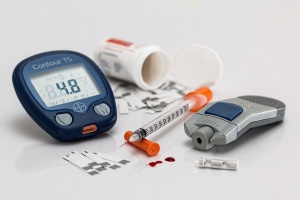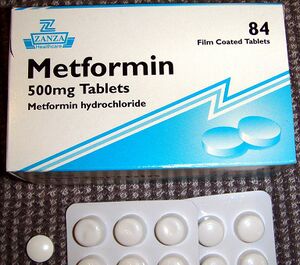Pharmacological Management of Diabetes Mellitus: Difference between revisions
No edit summary |
No edit summary |
||
| Line 1: | Line 1: | ||
<div class="editorbox"> '''Original Editor '''- [[User:Ashton Randolph|Ashton Randolph]] '''Top Contributors''' - {{Special:Contributors/{{FULLPAGENAME}}}}</div> | <div class="editorbox"> '''Original Editor '''- [[User:Ashton Randolph|Ashton Randolph]] '''Top Contributors''' - {{Special:Contributors/{{FULLPAGENAME}}}}</div> | ||
== Introduction == | == Introduction == | ||
[[File:Diabetes-528678 960 720.jpg|right|frameless]]Diabetes (a chronic disease) can be managed effectively with lifestyle modifications (eg | [[File:Diabetes-528678 960 720.jpg|right|frameless]] | ||
[[File:Human insulin 100 IU-1ml pen yellow background.jpeg|thumb|Insulin pen]] | |||
Having an understanding of these medicines will allow physical therapists to identify medical emergencies, | [[Diabetes]] (a chronic disease) can be managed effectively with lifestyle modifications (eg weight reduction, diet and exercise) and use of pharmacological agents.<ref>Ngugi MP, Njagi JM, Kibiti CM, Miriti PM. [https://www.researchgate.net/publication/270282424_Pharmacological_Management_of_Diabetes_Mellitus Pharmacological Managemen t of Diabetes Mellitus.] Asian Journal of Biochemical and Pharmaceutical Research. 2012;2:375-81. Available:https://www.researchgate.net/publication/270282424_Pharmacological_Management_of_Diabetes_Mellitus (accessed 22.1.2023)</ref> | ||
[[File:Metformin 500mg Tablets.jpeg|right|frameless]] | |||
Having an understanding of these medicines will allow physical therapists to identify medical emergencies, manage treatment sessions, educate patients, and refer to the proper healthcare provider when warranted. | |||
== Commonly Used Medications == | == Commonly Used Medications == | ||
# [[Insulin]] is a hormone made by beta cells in the pancreas. When we eat, insulin is released into the blood stream where it helps to move glucose from the food we have eaten into cells to be used as energy. With [[Diabetes Mellitus Type 1|type 1 diabetes]], the body produces little or no insulin as the cells that produce insulin have been destroyed by an autoimmune reaction in the body. Insulin replacement by daily injections is required. With [[Diabetes Mellitus Type 2|type 2 diabetes]] the body produces insulin but the insulin does not work as well as it should (referred to as insulin resistance). To compensate the body makes more but eventually cannot make enough to keep the balance right. Lifestyle changes can delay the need for tablets and/or insulin to stabilise blood glucose levels. When insulin is required, it is important to understand that this is just the natural progression of the condition.<ref>[[Insulin in the Treatment of Diabetes Mellitus|Insulin]]</ref> | |||
[[Insulin]] is a hormone made by beta cells in the pancreas. When we eat, insulin is released into the blood stream where it helps to move glucose from the food we have eaten into cells to be used as energy. | # [[Pramlintide in the Treatment of Diabetes Mellitus|Pramlintide]] is designed to be used in conjunction with [[Insulin in the Treatment of Diabetes Mellitus|insulin]] for patients who fail to control their glycemic levels with insulin alone. Pramlintide is similar in its structure and function to islet amyloid polypeptide (IAPP), which is a [[Hormones|hormone]] secreted along with insulin by Beta cells located within the pancreas . The role of this hormone is to aid in controlling postprandial [[hyperglycemia]], by suppressing glucagon secretion, reducing the rate of gastric emptying, and regulating food intake by sending satiety signals to the [[Brain Anatomy|brain]].<ref>[[Pramlintide in the Treatment of Diabetes Mellitus]]</ref> | ||
# [[Metformin]] reduces [[blood]] glucose levels by decreasing glucose production in the [[Liver Disease|liver,]] decreasing intestinal absorption, and increasing [[insulin]] sensitivity.Metformin decreases both basal and postprandial blood glucose. Metformin is considered weight neutral with the potential for modest weight loss. It is also unlikely to cause [[hypoglycemia]] and may be potentially cardioprotective.<ref>[[Metformin]]</ref> | |||
# [[Sulfonylureas in the Treatment of Diabetes Mellitus|Sulfonylureas]] is utilized in the treatment of [[Diabetes|type 2 diabetes mellitus]] when metformin is not sufficient. Sulfonylureas increase the release of [[Insulin in the Treatment of Diabetes Mellitus|insulin]] through the stimulation of pancreatic beta cells. Sulfonylureas, consequently, are a more potent medication in the earlier stages of type 2 diabetes when a patient has an increased pancreatic beta-cell function.<ref>[[Sulfonylureas in the Treatment of Diabetes Mellitus]]</ref> | |||
== Conclusion == | == Conclusion == | ||
Physical therapist need to be aware of the intended effects, as well as possible side effects of medications for diabetes, eg [[hypoglycemia]] and [[ketoacidosis]], that may be prevalent with certain medications. | |||
* Maintaining proper glucose levels can prevent sequelae of the disease, and can also impact the treatment session. | * Maintaining proper glucose levels can prevent sequelae of the disease, and can also impact the treatment session. | ||
Revision as of 07:16, 22 January 2023
Introduction[edit | edit source]
Diabetes (a chronic disease) can be managed effectively with lifestyle modifications (eg weight reduction, diet and exercise) and use of pharmacological agents.[1]
Having an understanding of these medicines will allow physical therapists to identify medical emergencies, manage treatment sessions, educate patients, and refer to the proper healthcare provider when warranted.
Commonly Used Medications[edit | edit source]
- Insulin is a hormone made by beta cells in the pancreas. When we eat, insulin is released into the blood stream where it helps to move glucose from the food we have eaten into cells to be used as energy. With type 1 diabetes, the body produces little or no insulin as the cells that produce insulin have been destroyed by an autoimmune reaction in the body. Insulin replacement by daily injections is required. With type 2 diabetes the body produces insulin but the insulin does not work as well as it should (referred to as insulin resistance). To compensate the body makes more but eventually cannot make enough to keep the balance right. Lifestyle changes can delay the need for tablets and/or insulin to stabilise blood glucose levels. When insulin is required, it is important to understand that this is just the natural progression of the condition.[2]
- Pramlintide is designed to be used in conjunction with insulin for patients who fail to control their glycemic levels with insulin alone. Pramlintide is similar in its structure and function to islet amyloid polypeptide (IAPP), which is a hormone secreted along with insulin by Beta cells located within the pancreas . The role of this hormone is to aid in controlling postprandial hyperglycemia, by suppressing glucagon secretion, reducing the rate of gastric emptying, and regulating food intake by sending satiety signals to the brain.[3]
- Metformin reduces blood glucose levels by decreasing glucose production in the liver, decreasing intestinal absorption, and increasing insulin sensitivity.Metformin decreases both basal and postprandial blood glucose. Metformin is considered weight neutral with the potential for modest weight loss. It is also unlikely to cause hypoglycemia and may be potentially cardioprotective.[4]
- Sulfonylureas is utilized in the treatment of type 2 diabetes mellitus when metformin is not sufficient. Sulfonylureas increase the release of insulin through the stimulation of pancreatic beta cells. Sulfonylureas, consequently, are a more potent medication in the earlier stages of type 2 diabetes when a patient has an increased pancreatic beta-cell function.[5]
Conclusion[edit | edit source]
Physical therapist need to be aware of the intended effects, as well as possible side effects of medications for diabetes, eg hypoglycemia and ketoacidosis, that may be prevalent with certain medications.
- Maintaining proper glucose levels can prevent sequelae of the disease, and can also impact the treatment session.
- Physical therapists are in a unique position because of the amount of time we spend with patients, and it is imperative that we play a role in monitoring their well-being.
References[edit | edit source]
- ↑ Ngugi MP, Njagi JM, Kibiti CM, Miriti PM. Pharmacological Managemen t of Diabetes Mellitus. Asian Journal of Biochemical and Pharmaceutical Research. 2012;2:375-81. Available:https://www.researchgate.net/publication/270282424_Pharmacological_Management_of_Diabetes_Mellitus (accessed 22.1.2023)
- ↑ Insulin
- ↑ Pramlintide in the Treatment of Diabetes Mellitus
- ↑ Metformin
- ↑ Sulfonylureas in the Treatment of Diabetes Mellitus









